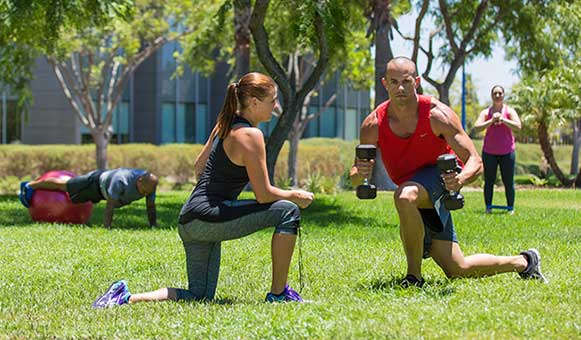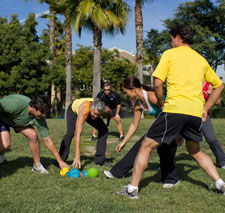
Once upon a time, a strong personal-training career could be built on exercise expertise and great trainer-to-client relationships. But that may not be enough in today’s competitive business environment.
People want to work out and have fun among friends, not just do another solitary workout. So for today’s trainer, fostering active client-to-client interactions is increasingly what separates profitable fitness pros from the pack.
Bottom line: Never forget that you are in the people business, not just the exercise business, says industry expert John Sinclair. And partner and group training present the perfect opportunity to introduce clients to each other and foster positive social relationships among your trainees.
Read on to discover exercise strategies that specifically support a culture of camaraderie during multi-client workouts, and how this will keep customers coming back for more.
Making the Multi-client Model Work
More Tips for Making Friends
Here are some bonus tips from our experts:
Scott Rawcliffe: “If you are doing a station-based circuit, instead of spreading everyone out so there is only one client per station, put two or three at each station, even if you only have a few people. They will naturally help push each other and during rests they will talk to each other.”
Tony Chemer: “Our staff discusses how clients are interacting [amongst each other] during our weekly trainer’s meeting. We talk about ways to make clients feel more at home and interact within the groups.”
John Sinclair: Your session plan is a template, not a definitive course of action, because different personalities will enjoy different types of games and competitions. Being able to adapt and create on demand is “the greatest skill a coach can develop,“ he says.
You may be used to delivering completely “personal” one-on-one training, but make no mistake: multi-client, “personalized” group training is where the industry is going, says Scott Rawcliffe, an international presenter and host of the Fit Pro Podcast who lives on the Gold Coast of Australia.
Consider the increasing popularity of partner workouts (two clients sharing one coach), small-group training (three to 10 clients per trainer), large-group training (10 to 15 clients per trainer) and even boot camps (trainer-led classes with no client limits). Why are these models growing? The social interaction of a group makes workouts more enjoyable, says Tony Chemer, the owner of Paradise Springs Fitness in West Bend, Wisc., and the lead trainer for Alloy Personal Training Solutions.
When your clients are friends with each other, “they tend to come in more consistently, and we all know that consistency is what generates great results,” says Rawcliffe.
“If clients have strong bonds to each other, not only does the trainer hold them accountable to showing up for their workouts, but they also hold each other accountable,” agrees Chemer. Groups also offer amicable competition. “If a trainer took me through a workout privately I would work hard, because I’m a motivated person. But if that trainer took four of us through together, we’d work harder,” Chemer explains.
A strong culture of camaraderie also puts referrals on autopilot, because people love to introduce their friends to fun activities, adds Brian Kalakay, the owner of Xtreme Results Gym in Lapeer, Mich., and the creator of the TT Boot Camp Games Programs.
Positive client-to-client relationships can (and should!) be developed outside of workouts—through organized social events, or via discussions in a closed, clients-only Facebook group. However, developing team bonds during workouts, especially for busy clients who have little time for non-exercise-related socializing, is key. Here are practical strategies that get clients interacting during sweat sessions.

Don’t just introduce yourself before the workout, introduce your clients to each other.
Or, make social introductions a game: Give your clients a set time (a minute perhaps) to meet at least two other trainees, and share a fun fact about themselves (favorite food, color, etc.).

There are many two-client exercises that encourage interaction—think back-to-back squats, medicine ball tosses or partner push-ups with high fives between reps. (Find more ideas and exercises here and here.)
But to really take partner maneuvers to the next level, pair trainees together and get them to “coach” each other, says Kalakay. This can occur in an instructor-led portion of class or within the stations of a circuit.
“One client exercises while the other counts reps and encourages, or watches the clock for a timed movement. The trainer is still in charge of overseeing the group, watching for form and making corrections, but the clients are encouraged to get more involved with motivating each other,” Chemer says.
Or try a Sandbell® game of catch, which John Sinclair, fitness director for Midtown Athletic Club in Weston, Fla., and a member of the PTA Global Faculty, sometimes uses with his clients. Pair clients together and have them each hold a light HyperWear Sandbell®. Clients toss the Sandbells to each other, alternating hands (catch and throw on the left, then catch and throw on the right, etc.).

Another useful strategy is to include a game at the end of your sweat sessions. These get clients interacting, talking and building relationships…and having fun together!
Kalakay uses many classics, such as duck-duck-goose, variations on tag, and dodgeball (he uses balled-up newspapers held together with masking tape instead of hard rubber balls to make the game more user-friendly). Kalakay also recommends playing music during games, and always sounding excited when you are explaining the rules to keep energy levels high.
For a quick game option, try a partner game like toe tag. “Clients try to touch the tops of their partner’s foot with their own foot as many times as they can in 30 seconds,” says Rawcliffe. The partner attempts to avoid being “tagged” on his or her foot. Rawcliffe offers a caution: “Make sure you clarify they are to touch their partners foot, not stomp on it. You'll be surprised how competitive clients can get!”

An occasional competition can be great fun. But be aware that form is likely to be sacrificed in the heat of the moment when clients compete against each other, says Rawcliffe. Avoid overly complex movements during contests for this reason.

Also make it clear that you expect everyone to cheer each other on, and you should lead by example with an encouraging attitude, Rawcliffe adds.
Rawcliffe offers a final caution: You never want to make any one individual feel like the “loser.” So if you are going to have participants compete against each other, do this as groups so no single person feels like they were the one who couldn’t keep up, he recommends. Or simply have clients race against themselves, or the clock, he adds.
Here are a couple of ideas to try:
Week-to-week Challenge: Have your clients see how many of a certain exercise (such as medicine ball slams) they can do in three minutes, says Rawcliffe. Do this for a few weeks in a row, to see if they can beat their score from week to week.
Medicine Ball Squat Pass: “Have the group form a circle and hold a squat at 90 degrees, while randomly passing a medicine ball back and forth across the circle,” says Chemer. “If you miss the ball or get out of your squat, you're out.” The last person standing wins.

“Races are always a big hit,” says Chemer. These are especially great to cap off the end of a hard workout. Split the group into teams and get moving!
Mini-obstacle Course Race: Chemer suggests setting up obstacle courses, including slosh pipe and farmers carries, flipping tires, or running around outside your building after doing 20 kettlebell swings.
Beat-the-clock Challenges: Have people split into groups of four, suggests Kalakay. Each group is collectively responsible for completing 100 push-ups and 100 squats total, within a certain amount of time (try four minutes). Or challenge participants to see how many of a certain exercise they can individually perform in a set time period, adds Sinclair.

Having everyone on the same team with the same goal creates a fun atmosphere and enhances energy. Try these variations:

Countdown Against the Clock: Give the entire group a set of exercises to complete within a certain time. Rawcliffe explains: “This can be as basic as a push-up/squat countdown (10 push ups, 10 squats, 9 push ups, 9 squats and so on). As the faster people start to finish they will cheer on those who are still working. This will raise the energy and build inter-client bonds.”
I-Go-You-Go Jump Squats: Partner clients up or split them into two teams, says Chemer. Then, the partner or the other half of the group holds a 90-degree squat while the other side performs 10 jump squats; then the roles are reversed. “Then they take turns to all do nine squats, eight, and so on down to one; then back up again (two, three, four…10). The sides keep taking turns like this until they complete all sets. This always creates a lot of laughter and very rubbery legs!”
Finish Together
“We end sessions with everyone in a huddle together. The trainer and clients all put their hands in the middle and say a [motivating] word-of-the-day as a team, and then break with our hands in the air,” says Kalakay.
Social Workouts = Success
“When you're looking at building a great culture or training environment, everything you do should be strategic,” says Rawcliffe. “Think about how you structure everything and always ask whether or not there is a better way to foster relationships among clients.”
“Too many times trainers just focus on creating hard workouts rather than effective and fun workouts,” says Kalakay. “It doesn’t matter how hard your workouts are; if people aren’t enjoying themselves they will not come back and they won’t tell their friends.”
To succeed, simply tweak your exercise programming to promote inter-client interactions, and the business side of things will take care of itself.





 by
by 










